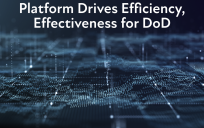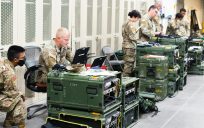This blog post is an excerpt from GovLoop’s recent research guide, “Connecting the Mission of the Defense Department to You.”
Leadership is tailored to an organization’s context, culture, climate and character. Defense Department leadership has evolved through a combination of discipline and training, military camaraderie and mission accomplishment.
And for today’s DoD, navigating ever-evolving challenges — like cyberwarfare, the Internet of Things and big data — requires strong leadership that embodies such qualities. In an interview with GovLoop, Greg Gardner, a retired U.S. Army Colonel and Senior Fellow at George Washington University’s Center for Cyber/Homeland Security, discussed the important leadership lessons he’s learned through his experience; challenges that military and civilian employees must navigate and how he sees the future of the DoD playing out with the digital and data-driven world we live in.
Lessons Learned: Listen
As someone with over 30 years of government service and IT experience who is now working for a technology firm, Gardner uses what he’s learned to help DoD organizations adopt the best practices and insights that the private sector and the intelligence community have to offer. He previously served as Deputy Chief Information Officer (CIO) for the intelligence community, where he assisted the CIO in developing the information management systems that enable an agile intelligence enterprise.
During his final military assignment, Gardner developed the prototype of the Joint Protected Enterprise Network (JPEN) that enables force protection information to be securely shared among DoD organizations. What has been most helpful is keeping a pulse on his teams, the organizations he leads and private-sector innovation.
For Gardner, leadership is not just about being ahead of the digital world. Leadership is about listening. “The most important thing to be a good leader within the government and military space is the willingness to listen to others, particularly your subordinates,” he said. “You have to recognize that you aren’t the cornerstone on good ideas, but that you can find them throughout the organization.”
Specifically, Gardner highlighted the importance of not just listening to others but listening to the “rhythms” of the organization you’re leading. This means being in tune with what’s going on in the organization, what changes need to be made and what those changes drive in terms of outcomes. Listening also means being in tune with what’s happening in government, as well as the private sector.
Finding the Fishermen for Big Data
With DoD networks under constant attack, officials have been at pains to develop necessary defensive measures. One approach is to leverage big data and associated analytical capabilities, which can play a large role in defending against a vast array of attacks.
Harnessing big data and analytics is a significant challenge for people in all levels of government, but particularly in the military, Gardner said.
“The difficulty with data analytics lies in integrating different sources to get benefits from that data,” Gardner said. “You have the challenge of deciding what is useful and what’s not.” Leaders in the DoD are tasked with finding the right people to sift through and leverage the data they collect. One analogy Gardner used to summarize the challenge of data is water and fishermen. “Data as water is pooled in puddles, ponds, lakes or oceans, and you have to figure out how that data moves,” he said. “Think of streams and creeks as different data stores. If you really want to mine the data properly, you need a fishing guide to that certain body of water to help you learn how to ‘fish’ there.”
What will be especially challenging for the DoD workforce is operationalizing this analogy. Where can the Defense Department get these “fishermen” or data analysts?
For developing the best workforce, Gardner emphasized the importance of collaboration with the private sector. In fact, DoD has already started to adopt the same big data techniques used by businesses to mine databases and glean more information from different types of data.
Humans can analyze some of this information, but there’s more to be mined from the thousands of gigabytes being continuously generated. Computer analysis can handle mundane tasks, freeing personnel to do tasks that better fit their talents. As DoD staffs train to be better data analysts or “fishermen,” leaders need to make sure they’re helping equip their staffs to monitor and understand inputs while computer analysis does the work of highlighting potential areas of interest.
Collaboration with Industry
The DoD’s mission is to provide U.S. security with up-to-date technology and industry innovation. Logically, leaders across the department should consider close collaboration with their private-industry counterparts.
Gardner praised the FY2016 National Defense Authorization Act for giving DoD authority to bring private-sector experts directly into the department. “That’s a good start,” he said. “The challenge for DoD is executing closer collaboration with the private sector. It is not easy, but as Secretary Mattis and his team face the challenges of a very uncertain world, they will need to evolve decision-making processes based more on digital products than the output of industrial systems. The private sector can help with that.”
While the role of private-sector collaboration with the DoD is complicated, particularly when it comes to acquisition rules, there are still many ways that leadership can work with industry. Again, listening plays a key role, but effective Defense leaders also find ways to bring their private-sector counterparts to the table and engage them in fruitful discussions.
“The DoD needs to have more discussions with industry, Gardner said. “Government leaders are often hesitant to talk to industry on specific details, while industry leaders can be afraid to open up for fear of abetting their competitors. But we need to have real substantive discussions between industry and government if we are to effectively grow our Defense capabilities.”
Leadership Best Practices
Finally, Gardner had three best practices for DoD leaders and employees alike to start applying in light of the digital economy, big data and collaboration with private-sector counterparts:
#1 Learn every day. Study data management and how it fits into your profession.
#2 Understand the challenges of the digital future. Accept the increased pace of the digital future and remain abreast of current and emerging trends.
#3 Get used to speed and change. Agencies like the DoD need to be ready to modernize as quickly as the private sector.
Ultimately, leadership in the DoD means having an ear to the ground when it comes to the needs of their organizations as well as remaining in tune with what’s going on in the digital world. Harnessing big data and analytics will be vital to shaping the future of DoD. But by collaborating with private-sector counterparts and encouraging the growth of data analysts, the DoD can dominate its adversaries in the digital future.





Leave a Reply
You must be logged in to post a comment.